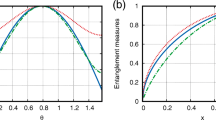Abstract
The notion of entanglement fidelity is to measure entanglement preservation through quantum channels. Nevertheless, the amount of entanglement present in a state of a quantum system at any time is measured by quantities known as measures of entanglement. Since there are different types of measures of entanglement, one may expect an entanglement fidelity to associate with its own measure of entanglement counterpart. Here, we aim to investigate association between the so-called entanglement fidelity and some measures of entanglement, namely, entanglement of formation, concurrence and negativity. New entanglement fidelities based upon these measures of entanglement are introduced and statistically compared with the so-called previously introduced entanglement fidelity. It is shown that the entangling aspect of the so-called entanglement fidelity is neither of type entanglement of formation and concurrence nor of type negativity. The results, in addition, expose inability of the so-called entanglement fidelity for detecting, in a broad sense, entanglement preservation through quantum channels. Our analyses open up a new venue in the study of entanglement fidelity and measure of entanglement by demonstrating that each measure of entanglement solely defines its own entanglement fidelity.




Similar content being viewed by others
References
Barnum, H., Nielsen, M.A., Schumacher, B.: Information transmission through a noisy quantum channel. Phys. Rev. A 57, 4153 (1998)
Bennet, C.H., DiVincenzo, D.P.: Quantum information and computation. Nature 404, 247 (2000)
Bennett, C.H., DiVincenzo, D.P., Smolin, J., Wootters, W.K.: Mixed-state entanglement and quantum error correction. Phys. Rev. A 54, 3824 (1996)
Hill, S., Wootters, W.K.: Entanglement of a pair of quantum bits. Phys. Rev. Lett. 78, 5022 (1997)
Horodecki, M., Horodecki, P., Horodecki, R.: Separability of mixed states: necessary and sufficient conditions. Phys. Lett. A 223, 1 (1996)
Horodecki, R., Horodecki, P., Horodecki, M., Horodecki, M.: Quantum entanglement. Rev. Mod. Phys. 81, 865 (2009)
Kendall, M.G., Gibbons, J.D.: Rank Correlation Methods. Charles Griffin Book Series, 5th edn. Oxford University Press, Oxford (1990)
Miranowicz, A., Grudka, A.: Ordering two-qubit states with concurrence and negativity. Phys. Rev. A 70, 032326 (2004)
Nielsen, M.A.: The entanglement fidelity and quantum error correction. ArXiv preprint arXiv:quant-ph/9606012 (1996)
Nielsen, M.A., Chuang, I.L.: Quantum Computation and Quantum Information. Cambridge University Press, Cambridge (2010)
Peres, A.: Separability criterion for density matrices. Phys. Rev. Lett. 77, 1413 (1996)
Schumacher, B.: Sending entanglement through noisy quantum channels. Phys. Rev. A 54, 2614 (1996)
Steane, A.: Quantum computing. Rep. Prog. Phys. 61, 117 (1998)
Vedral, V., Plenio, M.B.: Entanglement measures and purification procedures. Phys. Rev. A 57, 1619 (1998)
Vedral, V., Plenio, M.B., Rippin, M.A., Knight, P.L.: Quantifying entanglement. Phys. Rev. Lett. 78, 2275 (1997)
Vidal, G.: Entanglement monotones. J. Mod. Opt. 47, 355 (2000)
Vidal, G., Werner, R.F.: A computable measure of entanglement. Phys. Rev. A 65, 032314 (2002)
Virmani, S., Plenio, M.B.: Ordering states with entanglement measures. Phys. Lett. A 268, 31 (2000)
Wootters, W.K.: Entanglement of formation of an arbitrary state of two qubits. Phys. Rev. Lett. 80, 2245 (1998)
Xiang, Y., Xiong, S.J.: Entanglement fidelity and measurement of entanglement preserving in quantum processes. Phys. Rev. A 76(1), 014301 (2007)
Acknowledgements
This research was supported by Department of Applied Mathematics and Computer Science at University of Isfahan (Iran) and in part by a grant from IPM through Grant No. 98810042.
Author information
Authors and Affiliations
Corresponding author
Additional information
Publisher's Note
Springer Nature remains neutral with regard to jurisdictional claims in published maps and institutional affiliations.
Rights and permissions
About this article
Cite this article
Azimi Mousolou, V. Entanglement fidelity and measure of entanglement. Quantum Inf Process 19, 329 (2020). https://doi.org/10.1007/s11128-020-02808-0
Received:
Accepted:
Published:
DOI: https://doi.org/10.1007/s11128-020-02808-0




